How iCloudEMS eases the journey of Accreditation for Higher Education Institutes
Today the quality education is the benchmark of Higher Education Institutes to build their trust in the society, nation and the world. To up-skill the youth according to today’s demand of employability and Higher Studies, the number of professional programmes is increasing at a high rate. Thus, the Quality Assurance has become imperative for the Higher Education programmes to prepare a knowledgeable and skilled workforce. Accreditation is a quality monitoring measure to check how well the Institutes or Programmes are able to stand on the pre-defined parameters by the governing bodies. New Education Policy recommends the holistic development of students to foster 21st century education competencies, which are more focused on the development of critical thinking, communication skills, research, problem solving skills etc.

Accreditation is a series of rigorous procedures that ensure social, technological and industrial development in the students. In 1994 University Grants Commission (UGC) and All India Council for Technical Education established autonomous bodies named National Assessment and Accreditation Council (NAAC) and The National Board of Accreditation (NBA) to evaluate the all-round quality parameters of Higher Education Institutes. Accreditation impetuses the Higher Education Institutes towards continuous quality development. The exhaustive measures of Accreditation include organizing and compiling the data of several years with generation of multi-level self-analysis reports to iteratively benchmark the standards. NEP has emphasised the extensive use of technology in teaching and learning practices and for efficient educational planning and management. This has promoted the Institutes to leverage the reliable Edu techs in aligning their administrative and non-administrative workflow standards compliance with the external audit or regulatory bodies
iCloudEMS was founded in 2017 on the notion that “We honour Great Education and Great Educationists”. We offer various cutting-edge cloud-based products to give the unified Education Management Solutions. Our Accreditation Management System assists the institutes and the associated staff to smoothen their workflow towards achieving the best position in accreditation endeavours.
Our key utilities include:
- We offer a comprehensive accreditation information system comprising SIS and other different modules which is designed for every kind of technical and non-technical Higher Education Institutes and that delivers results compliance with Washington accord, LIMA accord and Bologna process.
- Our system supports powerful reporting tools to generate numerous self-assessment and analysis reports such as SER/SAR/AQAR/IQAC/ AACSB required for your institution with a couple of clicks only
- We deliver the services for errorless mapping the learning outcomes with the mission and vision of the institute that ensures to follow continuous quality monitoring and enhancement mechanisms.
- We present a digital space to easily review accreditation phases and determine the plans and strategies to align the pre-set goals of the institute. It validates the right Implementation of OBE and consistent feedback practice for regular quality check and upgradation.
Benefits of our Accreditation Management System to Higher Education Institutes.
Our Accreditation Management system offers the following advantages to Higher Education Institutes:
- Accreditation bodies generally demand and evaluate data of several years, but organizing and formatting such a huge data manually is a herculean task and is also vulnerable to redundancy and missed information. Our cloud-based system simplifies the data management and formatting in line with the regulations.
- Today it has become necessary to upload the data on Accreditation portals before the visit of the peer team, our innovative functionalities facilitate the bulk data uploading process that also includes the facility to use the prefilled data on the portal during the process of the multiple years data collection.
- The data is mainly asked to be filled as the answers of a few predefined Questions, following the same guidelines we help the administration to fill their data according to the Answers of Questions in different evaluation criteria.
- Examining its own abilities is an important step in Accreditation process, and reports mention results better than words. We assist faculty members by automating the generation of main self-assessment reports along with different supporting reports in the course of accreditation assessments and qualification analysis.
- Our expert database verification team performs close analysis of the standards and the criteria to be validated upon through the compilation and management of data in chronological order.
- Our quick and flawless results alleviate the DVV clarification by governing bodies.
- We have a multilevel evaluation process with the help of which, Institutes can rapidly check the benchmarking standards and get a ready reckoner on the current status.
In today’s competitive world, Quality assurance of Higher Education Institutes or Programmes is necessary to prepare educated and skilled young minds who can contribute towards global progress. Thus, quality enhancement at all levels is the focus of the modern Higher Education system. Accreditation bodies such as NAAC, NBA, ABET, AACB help the institute to benchmark their standards and motivate them towards Continuous Quality Improvement. All these bodies have established their quality parameters, and the Institutes willing to get accredited are required to follow their guidelines and series of steps on which these can be evaluated for quality maintenance and improvement. iCloudEMS strengthens the Higher Education Institutes by digitizing the groundwork of accreditation and aligns myriad preparatory activities in compliance with the regulatory bodies to assure the flow of quality in the successful journey of accreditation.
How accreditation bodies evaluate Higher Education Institutes for Quality assurance
Accreditation is a rigorous process under which Higher Education Institutes (HEIs) are evaluated if they meet pre-established standards of governing bodies. Ministry of Human Resource Development (MHRD) and the University Grans Commission (UGC) have taken many initiatives time to time for the assessment of quality standards of HEIs. Subsequently, the National Policy on Education (1986) and Programme of Action (1992) recommended to establish an autonomous Accreditation and Assessment body for the maintenance and promotion of standards of Higher Education. In 1994 University Grants Commission (UGC) established an autonomous institution named National Assessment and Accreditation Council (NAAC) to evaluate and promote the quality in Higher Education. NAAC strives hard to undertake plans and activities for the accomplishment of its vision and mission to make quality, an Integrated element of Higher Education in India with major concern on prepare youth with high values and global competencies who can contribute to national and global development.
Benefits of Accreditation: Following are the important benefits of getting accredited:
- Accreditation pushes the Institution towards its SWOT analysis and its improvement.
- Accreditation builds the trust and accountability of Institutes among students, parents and society on quality education offered.
- Funding agencies are more interested to invest their financial resources in the progress of accredited institutes,
- Accreditation directs the Institutes for Continuous Quality Improvement.
Process of NAAC accreditation
The NAAC follows a combination of self and external quality measures for promotion and sustenance of quality parameters that include:
- First the HEIs willing for accreditation get themselves registered on the NAAC website
- Then Institutes are required to prepare and submit Institutional Information for Quality Assessment (IIQA) first and Self Study Report (SSR) on acceptance of IIQA
- Next step is to proceed to Student Satisfaction Survey (SSS) and Data Validation & Verification (DVV) process for thecalculation of Pre-qualifier Score
- Once all the reports and scores are there with NAAC then an on-site visit of peer team is done following the grading of Institute is declared.
Criteria for assessment:
Following seven criteria are considered as the basis of assessment procedures:
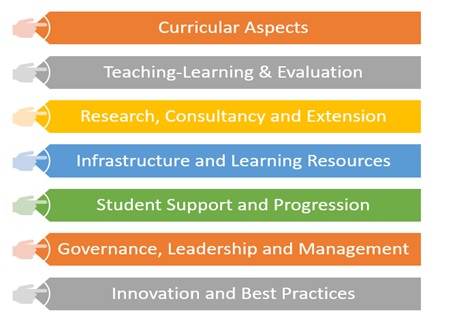
Curricular Aspects: NAAC Criterion I is all about the evaluation of curriculum features of Higher Education Institutes that comprise the planning, designing and implementation of curriculum of various programme and courses of HEIs. The Curricular Aspects are the backbone of Higher Education System. Though, the curriculum practices are different according to the academic and administrative levels of Institute i.e., whether the task has been performed by university, affiliated institute or autonomous institute. The key concern for evaluation deals with the assessment of curriculum enrichment of various programme and courses to check its relevant of national and global needs in terms of multi-skill development and academic flexibility. Curriculum updating is also judged by assessing the involvement of feedback procedures and stakeholders’ participation
Criterion I is assessed in the following Key areas:
- Curriculum design and development,
- Curriculum planning and implementation,
- Academic flexibility,
- Curriculum enrichment,
- Feedback system.
Teaching-learning & Evaluation: NAAC Criterion II is to gauge the efforts made by institution towards catering the needs of students belonging to different backgrounds, with its effective teaching-learning practices. The innovative teaching skills that promote students’ engagement with the help of interviews, focused group discussions, debates, projects, presentations, experiments and applications of technology resources are reviewed. As the teaching-learning are key concern hence the proficiency of faculty is analysed with the institutional efforts for their continuous faculty development.
Criterion II is assessed in the following Key areas:
- Student Enrolment and Profile
- Catering to Student Diversity
- Teaching-Learning Process
- Teacher Profile and Quality
- Evaluation Process and Reforms
- Student Performance and Learning Outcomes
- Student Satisfaction Survey
Research Consultancy and Extension: NAAC Criterion III pertains the information collected on the policies, practices and outcomes of the institution, with reference to research, innovations and extension. It is concerned with the fostering of research culture by undertaking research projects useful to the society and efforts made by institution for the same.
Criterion III is assessed in the following Key areas:
- Promotion of Research and Facilities
- Resource Mobilization for Research
- Innovation Ecosystem
- Research Publications and Awards
- Consultancy
- Extension Activities
Infrastructure and Learning resources: NAAC Criterion IV focusses on the resources available in an Institution and how are these deployed for quality sustenance in the academic programmes. I also seek information on the benefits students, teachers and other staff using these available facilities in the campus. Criterion IV is assessed in the following Key areas:
- Physical Facilities
- Library as a Learning Resource
- IT Infrastructure
- Maintenance of Campus Infrastructure
Student Support and Progression: NAAC Criterion V reviews the efforts made by an institution towards the holistic development of students to make them well capable to enter into the challenging world. either to pursue Higher Education or to get rewarding profession after they leave the campus.
Criterion V is assessed in the following Key areas:
- Student Support
- Student Progression
- Student Participation and Activities
- Alumni Engagement
Governance Leadership and Engagement: NAAC Criterion VI pertains the operational policies and practices in the institution with respect to recruitment, training, performance appraisal of human resources and the effective financial management and overall leadership role.
Criterion VI is assessed in the following Key areas:
- Institutional Vision and Leadership
- Strategy Development and Deployment
- Faculty Empowerment Strategies
- Financial Management and Resource Mobilization
- Internal Quality Assurance System (IQAS)
Institutional Values and Best Practices: NAAC Criterion VII An educational institute has its social responsibility to be solution giver for the emerging national and global challenges with its variety of programmes. Every institute is expected to implement unique practices towards the major domains such as gender equity, environmental consciousness and sustainability, inclusiveness and professional ethics. These academic and administrative practices to be impactful in these pressing issues are considered as best practices of the institute and these unique ways are reviewed during the accreditation process for the evaluation.
Criterion VII is assessed in the following Key areas:
- Institutional Values and Social Responsibilities
- Best Practices
- Institutional Distinctiveness
Following table represents the weightage given to the various Criteria.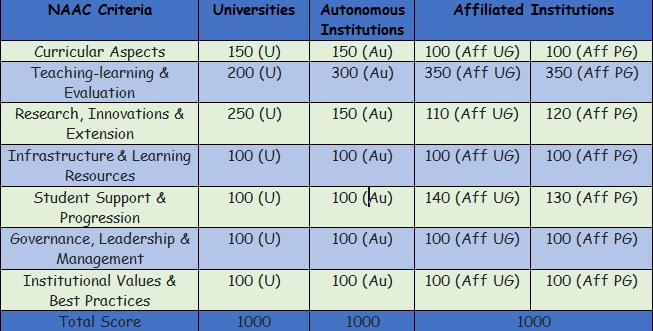
Source: NAAC Website
(U) – applicable only for Universities and Autonomous Colleges (A) – applicable only forthe Affiliated / Constituent Colleges
Grading System of NAAC Accreditation:
| CGPA | Letter Grade | Status |
| 3.51- 4.00 | A++ | Accredited |
| 3.26-3.50 | A+ | Accredited |
| 3.01-3.25 | A | Accredited |
| 2.76-3.00 | B++ | Accredited |
| 2.51-2.75 | B+ | Accredited |
| 2.01-2.50 | B | Accredited |
| 1.51 – 2.00 | C | Accredited |
| ≤ 1.50 | D | Not Accredited |
Source: NAAC Grading
“A grade qualifier is kept for the institution on qualify for valid accreditation. In order to qualify for any Grade (C to A++) Institution needs to score at least 1.51 CGPA aggregated score (quantitative and qualitative) in each criterion”. [from NAAC grading system]. Once the grade qualifier is finalized, accordingly the Cumulative Grade Point Average (CGPA) of an institution is calculated by collating scores of the total, the scores obtained during Peer Team through on site visit and the scores computed using the Student Satisfaction Survey, on a five-point scale.
Accreditation Management System: iCloudEMS offers a a cloud-based accreditation management system designed to cater the groundwork needs of higher education institutions and helps them to generate, collect, organize and administrate all required data and reports in the predefined formats given by regulatory bodies such NAAC, NBA, ABET, NIRF etc. The academic leaders can get the following advantages with our Accreditation Management System that helps to save their time and efforts in performing tedious and repeated tasks with a couple of clicks only:
- We offer a centralized platform to enter and govern data on a with respect to criterion wise predefined Question set.
- There is also a provision for kind perusal of data by concerned authorities to track the progress in real-time that helps to identify gaps compliance to pre-established standards.
- Our system supports Powerful reporting tools with standard formula set to generate analysis reports such as SER/SAR/AQAR/IQAC/ AACSB and many supporting reports in the course of accreditation assessments and qualification analysis.
- Our system is equipped with different templates that ease the bulk data uploading process of several years.
- The system also includes facility to use the prefilled data on portal during the process of the multiple years data collection.
- We empower Outcome based Education model in HEIs and centralizes the outcome-based data and reports of programmes and courses such as PO-CO mapping results, survey reports, rubrics data for calculation of direct and indirect attainment levels.
- We have an Expert Database Verification team for close analysis of the standards and the criteria to be validated upon.
- You can rapidly check the benchmarking standards and get a ready reckoner on the current status.
iCloudEMS supports Colleges and Universities to streamline the planning, assessing and analysing the several years of data and reports. We bring the organization under one roof to channelize the collective efforts of all stakeholders towards the achievement of their goals in the journey of accreditation.
How leveraging technology in Higher Education envisages the global competitive learning landscape
Education plays a significant role in shaping the future of the nation and technology plays an important role in restructuring the education practices to improve learning outcomes. Thus, Education and Technology has a mutual relationship that foster the national and global progress.
To deliver high quality education in each part of country,especially the remote cities and villages, NEP 2020 has come up with some major recommendations to bridge the digital divide with the deployment of technology in Education, as only technology has the potent to make it accessible and affordable. It also emphasised the role of EdTechs to elevate the digital preparedness of institutes and their stakeholders.
The outbreak of Covid-19 has impacted every sphere of the world, but every dark cloud has a silver lining and the same has been realized with the Education sector. The global pandemic has demonstrated the different phase of globalization in Education. It has made everyone to accept the deployment of technology in learning to maintain its continuity across borders.
Use of Technology in Higher Education

Higher Education Institutes have always taken prompt actions in adopting the technological advancements and made computers and telecommunications technologies as integrated part of their education system including e-mail, projectors, computers and many more. With the 21st century Education demands, there is need to reform Higher Educations system by utilizing the latest technologies to remove the space and time barriers and promote lifelong learning.
Technology has not left any stone unturned to impact on teaching-learning practices of Higher Education Institutes. The fusion of technology with classroom learning has made the sessions more collaborative and practical. Similarly, the Online Classes are organized using the advanced digital learning tools, have proved a flexible and cost-effective approach to obtain the 21st Century skills with innovative and functional pedagogical measures.
Nowadays, the role of instructors has been more inclined as a facilitator who can guide the students to learn the right way to obtain required information from web-based resources that assist the instructors to tailor more active and interactive sessions such as seminars, brainstorming and discussions for better grasping of concept.
The assessment of students has also been computerized with ingenious Online Examination and Evaluation processes, under which the cyberspace is utilized to conduct vigilant examination and the results calculation are also automated that reflect quick and accurate grades computation.
Not only classes and examination but technology has also dramatically changed theway of Institutional managementfor the hassle-free management of human and material resources.
Technology and Globalization in Higher Education

Prime Minister Narendra Modi has emphasised the role of NEP 2020 in creating an Atmanirbhar Bharat. He says NEP 2020 envisages the reformation of Education system to make India a global knowledge superpower by enabling India to play leading role in technology and globalization.
The accelerated use of Information Communication Technology (ICT) has created global communication networks and empowered globalization in Education. Globalization removes the boundaries to work worldwide in teams that ensures the global collaboration among the trained and innovative minds to serve local and global needs. The globalization has stretched the wings of the aspiring students to enhance the world-wide interaction, innovation, resources and prospects. UGC has taken many constructive initiatives towards the technological disruptions and globalization for the delivery of affordable and quality online higher education across regional and national borders. This includes the nod to cover 40% of the course curriculum online so that the students can reap the benefits of learning from experts without the need of classroom boundaries.
Role of iCloudEMS in the development of tech-savvy campus
Higher Education Institutes are putting their best efforts in to practice to implement labour-saving mechanism so that the time and energy of stakeholders can be effectively channelized to foster research and innovation at par with global standards. iCloudEMS has always performed exceptional to incorporate digitization in the daily tasks of Colleges and Universities. Our cutting-edge products automate the workflow of the Institutes to empower student-centric learning. Have a look at our major functions that generate a tech-savvy institute keeping the assorted needs of stakeholders in consideration:
- We offer a cloud-based platform to access and process huge amount of data and reports that saves the time and efforts of administration.
- We boost outcomes-oriented education culture by assisting the faculty in designing and mapping of learning outcomes with the academic elements.
- We automate the imperative functions such as attendance record, timetable preparation, assignment uploading and many more with a few clicks only.
- We encourage the Choice based credit System by simplifying the allotment of desired core and elective courses according to the choice of students.
- We facilitate the groundwork of accreditation computerizing many repeated and tedious tasks.
- We bring the entire academic journey of all students on a dashboard to make it ready for use anytime and anywhere.
- We strive for overcoming the physical barriers in high quality learning and assessment with our Online Classes and Examinations utilities.
- We make the system user-oriented and convenient for users with our training and assistance team.
Conclusion
Many institutions have technologized their organizational approaches to bring the change in their educational standards and to internationalize their programmes and courses. The NEP’s endeavours such as multi-point entry-exits and credit banks are the provisions to enhance the seamless mobility of students world-wide for a flexible and multi-disciplinary education paradigm. iCloudEMS promises the best efforts to bring the digital revolution in Higher Education Institutes that enable to produce globally adaptive, skilled and responsible workforce.
Why OBE has become the need of the hour of Quality
“Education is not the learning of facts, but training the mind to think”- Albert Einstein
The main aim of Higher Education system should be to prepare young minds who can participate a in knowledge-driven society and can also improve the national economy in globalized world. Today era of competitiveness demands to raise the academic standards where students are no longer required to be treated as knowledge receiver while they enjoy their equal involvement in sharing knowledge with teacher and expects the teacher to be guide in showing the path for right implementation of their skills. Such kind of Education approach can be implemented under Outcome-oriented Education model or Outcome Based Learning (OBE).
What is OBE
OBE is acronym of Outcome Based Education which demands every element including Instruction, Curriculum and Assessment of Educational system should be focused around a set of learning outcomes in such a way that Learning should actually happen.
In simple words, OBE is a paradigm shift in Education system that shifts the focus of Education from Instructional Objectives to Observable Outcomes.
What are Outcomes:
Outcomes are the tangible actions that demonstrate the learning of students at the end of Course or Program. The verbs given in Bloom’s taxonomy framework clearly give the performance indicators to be used while designing learning Outcomes.
OBE framework
Following diagram presents the OBE implementation structure in Higher Education Institutes with the mentioned outcomes given as:
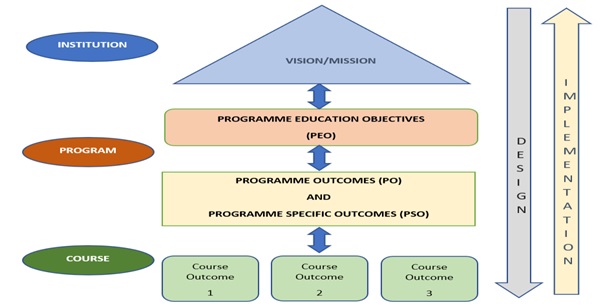
- Programme Outcomes (POs) are the confined statements deals with the competencies what students are expected to possess by the time of graduation. POs are expected to be aligned with knowledge, skills and attitudes of a graduate.
- Program Educational Objectives (PEOs) are the comprehensive statements that describe the career and professional goals that the program is preparing graduates to achieve.
- Program Specific Outcomes (PSOs) are statements that describe what the graduates of a specific program should be able to do.
- Course Outcome (CO) are the statements that reflect the cognitive knowledge skills that a course provides and a learner can demonstrate at the end of a theory, practical or theory cum practical subject.
Benefits of OBE:
In the traditional method of learning, teacher is always responsible for imparting knowledge which is based on rigid instruction-driven methodology and demonstrates what the instructors practice while OBE model is a flexible approach where students take the responsibility for the actualization of learning and teacher facilitates the conducive learning ecosystem to consolidate the competencies and innovative education. Following are the major benefits of OBE:
Outcomes-oriented: OBE implementation gives the clear insights of accomplishments by the end of learning at all levels, to both students and instructors. Students find the learning expectations beforehand and teachers can tailor their teaching strategies accordingly. The predefined learning outcomes also make the other fundamental components such as curriculum, content, assessment easy to be designed and practiced to achieve the desired knowledge and skills.
Outcomes-Mapping: The predefined outcomes make the analysis easier by mapping the progress of Institute with the articulated outcomes that reflects their improvement domains. Similarly, the mapping of students’ performance with defined outcomes allows tracking the accomplishment curve of the students.
Flexibility: OBE calls for student-centric learning which is not dependent on specific instruction methodology while the teacher acts as a facilitator where he is expected to recognized the diverse needs of students and structure his teaching approach in line with the accomplishment of learning goals.
Engagement: Students’ engagement in the learning sessions is the vital element of OBE. Students get the full-time access to study material and other resource which make them govern their own learning. Teachers are expected to guide them in the classroom sessions to make the best of time in brainstorming and innovative activities to involve them in skill-based learning.
Curriculum structure under OBE model:
Curriculum composition under OBE model is always oriented towards the globally adapted outcomes that can facilitate quality teaching-learning strategies and assessment ensuring seamless international mobility of students.
Teaching and Assessment under OBE framework
The teaching practices under OBE paradigm are customized according to the individual needs of students and required to follow active pedagogical practices to empower practical skills, technology-driven and field-based that can demonstrate the connection between theory and its applications.
The assessment procedures also concentrate on the progress direction of learning outcomes of course or program. Such assessment methods comprise time-based examination, open-book tests, assignments, project demonstration etc. which can clearly reflect the accomplishment of outcomes and ultimately the skill-set and values of the learners.

Recently UGC has released a ‘Quality mandate’, 277-page book that emphasises the implementation of Outcome-based academic activities in Higher Education Institutes that focus on skills and outcomes. iCloudEMS is a Cloud-based Education management system that understands the importance of learner-centric approach towards building the knowledge, skills and aptitude in students to bring sustainable national development. Our advanced products help Higher Education Institutes to reform their education system by aligning their workflow in line with OBE guidelines.
OBE is all about outcomes-oriented education and we at iCloudEMS deploy innovative technological features that automate the designing and mapping of outcomes in all the academic elements with its following attributes:
- A cloud-based server to store huge amount of data and records for effortless record management that assist the instructors to track the accomplishment status of outcomes.
- Innovative solutions to automate attendance record, timetable preparation, assignment uploading, results publishing to help the students in self-govern their learning.
- Smart course opting and allotment strategies to empower flexible and progressive learning culture
- OBE-LMS that boost the Outcomes-oriented culture by creating engaging course content and assignments with creative outcomes designing and mapping approach.
- NBA directly states: ‘No OBE, No Accreditation’. Our OBE supported executions, opens the door of accreditation for Institutes and our Accreditation management system computerizes the groundwork of regulatory exercises to save valuable time and efforts of the staff in performing repeated and tedious tasks.
- Student-lifecycle management system, to access the entire academic journey of the students with a couple of clicks only that empowers the student-centric learning by nurturing Continuous Quality Improvement ecosystem.
- Online Classes and Examinations system to foster strategic execution of OBE in all pre and post examination activities ranging from preparing Question papers to publishing final results, all take care of designing and mapping of all components with re-established outcomes.
- An affordable and user-friendly portal with powerful reporting tools for the quick statistical analysis at all levels.
In a nutshell it can be stated that OBE is the quality academic journey of Higher Education Institutes that is geared towards WHAT is learned, and WHETHER is learned well to make the graduates well-capable to enter in the challenging real-world. iCloudEMS technologies the campus that incorporates automated mapping of course and program attributes compliant to OBE and Bloom’s taxonomy and furnishes all the requirements to model learner-centric education in Higher Education Institutes.
How Online Classes have increased the quality and accessibility of Higher Education
The emergence of advanced digital technologies such as Artificial Intelligence, Machine Intelligence, Cognitive system etc. has improved the quality and accessibility of Higher Education to a large number of students. Department of Higher Education, Ministry of Human Resource Development, has taken many Digital Initiatives to bring Quality Education to students at each corner of nation.National Mission on Education through ICT (NMEICT) is a significant project of Ministry of Human Resource Development (MHRD) to blend technology with education with its major initiatives like SWAYAM, SWAYAM Prabha, E-Yantra, Virtual Labs etc. for the accomplishment of learning outcomes.
Quality Higher Education plays the considerable role to build a self-reliant and resilient nation. Covid-19 has paved the way to restructure Higher Education System in the way to make it universal accessible for all the students including at rural and remote areas.The unprecedented massive disruption of Education through global pandemic has made us adaptable to the New normal of learning where smart classes, online classes, virtual labs are the vital organs of Education system during and after pandemic. Thus, imparting skill-based higher education on the digital avenue has become the need of the hour.
Online Classes are web-based sessions which are conducted using digital learning tools such as Learning Management System (LMS) that can be conducted as LIVE sessions or the recorded sessions. In the first case, students can learn at their own convenience with available digital resources while the second case demands the active involvement of both teacher and students on real-time basis. But both the scenarios are aimed towards flexible and progressive learning with innovative pedagogical practices such as Flipped Learning, Blended Learning, Rapid Learning etc. to meet the educational demands of 21st Century.
The biggest benefit of such technology-driven classroom is that both teachers and students can constructively channelize their time and energy to make functional and fun-loving learning.
Following are the major benefits of Online Classes to Teachers and Students:
- Flexible: Both teachers are students are free to schedule their learning according to their mutual preferences and in different learning styles to fill the gaps and enhance the outcomes accomplishment.
- Cost-effective: With affordable and accessible Internet plans and one time device investment, Online learning has proven to be more cost-effective as there is no regular cost of commuting and physical resources.
- Collaborative: Online learning tends to improve the pupil-teacher and peer networking across borders without any cultural boundaries that help to easily incorporate research and innovation for implementation of theories in learning.
- Digital documentation: The online database of study material and reports simplifies the setting and tracking of targets with all-time accessibility of required inventory.
- Communication: The large number of students and physical disturbances restricts the personalized teacher attention to every student while this is not the case in Online classes, so these are observed to be more student-centric to fill the learning gaps efficiently.

What iCloudEMS offers teachers and students to make the best of Online Learning:
iCloudEMS offers cloud-based unified solutions to empower Online Education in Higher Education Institutes. It integrates prime Virtual Classroom settings withits cutting edge features to deliver Online LIVE classes to promote high quality education and foster Outcome based Education and Bloom’s taxonomy ecosphere to provide skill-based education and enhance the cognitive abilities of students.
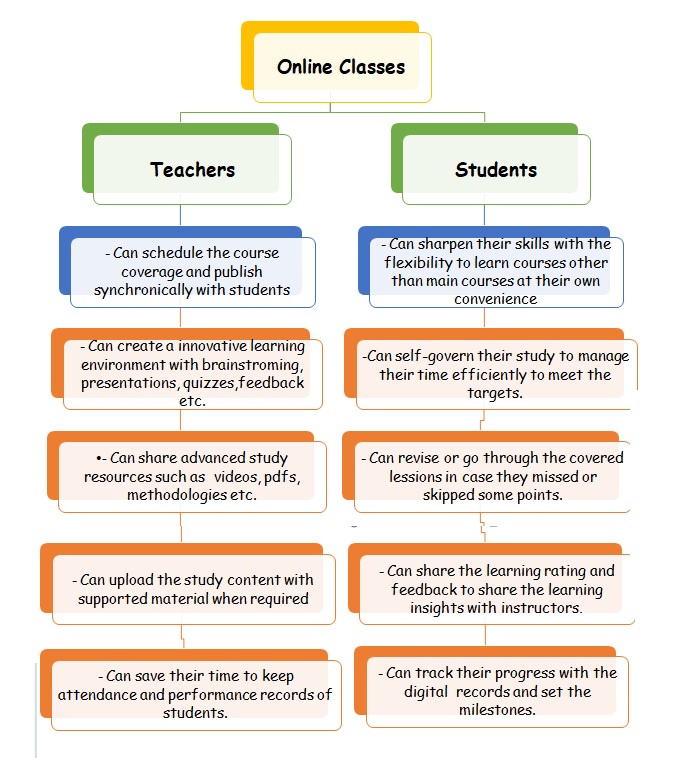
The National Education Policy (NEP) 2020 puts emphasis on the relevance of online education. It aims to deploy online platforms such as DIKSHA and SWAYAM (Study Webs of Active learning for Young Aspiring Minds) to maximize the digital learning according to their own choice of courses and schedule. The recent situations such as Epidemics and Pandemics call for leveraging the ICT-based Education while addressing all the possible challenges and reap its benefits where traditional classroom learning is not possible. iCloudEMS has always welcomed the technological needs of Institutes to nurture the modern education culture in digital-driven environment.
Digital Teaching & Learning: A New Revolution in the Field of Education
Due to the sudden outbreak of pandemic, lives of the people took a massive turn and everything changed…the change we all were not ready for but as it is said that “Change is the only constant” and so, it becomes necessary to accept it and follow the mantra of “Learn, Unlearn & Relearn”. In the field of education, Digitalization has become an integral part as it the resourceful use of digital technologies and tools throughout the teaching and learning process.
Digitalization in education sector has replaced traditional teaching system and lots of institutions are adopting this technology as the solution for the suspension of face-to-face teaching. The most importance benefits of digital teaching and learning are:
- Tailored & Personalized Learning:
iCloudEMS takes care of the visionary needs of Higher Education Institutes and delivers a web-based & Outcome-Based Learning Management System (OBE-LMS) to strengthen the deployment of prime technology in managing and organizing the academic workflow. It provides an opportunity to assist students in personalized learning as the teachers can customize the curriculum based on students’ learning pace and capability. Students can download recorded lectures and provided study material for revision and practice. - Brings Digital Smartness in Teachers and students:
Teachers and students have started acquainting themselves with these digital technologies and acclimatizing themselves with the changing times. By getting trained about different teaching and learning tools, teachers and students are enabling themselves to learn faster and use online resources as faster as they can. Digital technologies can enhance their efficiency and productivity. iCloudEMS with the help of its managed services, is assisting University ERP system and College ERP software so that the digital tools can sharpen critical thinking skills, reasoning skills and ameliorate the confidence in order to motivate them to learn even more new things like various online teaching apps, recorded live classes, certification and training programs, digital classrooms etc. - Involvement of important stakeholders like teachers and parents:
Digital learning tools and technologies like social learning platforms have made it easy for the teachers to create and manage students’ and parents’ groups. The opportunity to customize learning sequences for each student has made education more productive and has accelerated the overall progress. With the help of products like OBE-LMS, Online exam management system and Student Lifecycle management system, teachers can design assessment activities and exam papers, take prompt actions for unethical behaviour of students during the exam and generate the results on the spot. Parents too can remain informed about the time table of classes and exams, can observe the ongoing classes and share their experiences with the management and get their children’s results to analyse the performance. - Assisting the Institutions in getting Accredited with authentic means:
Accreditation for an institute has become compulsory to survive. iCloudEMS provides it managed services to the University/College ERP software in simplifying the accreditation process by automating the tasks aligned with accrediting bodies, maintaining OBE LMS by conducting online classes smoothly, generating authentic and accurate reports without any errors, controlling the examination and evaluation process assuring completely genuine results and providing transparent portal for the students’ and parents’ feedback to assess the overall performance of the institute.
To conclude, we can say that Digital learning tools and technology is filling the gaps where traditional classroom teaching fell behind. In fact, some of the efficiencies such tools bring are simply unmatchable by traditional learning techniques. From the environmental impact recognized by the need for less paper for handouts and books to saving time with quick access to information and the ease of research, digital learning provides an effective way to cut costs, maximize resources and heighten both reach and impact for students and educators alike.
How to use the cyberspace effectively for uninterrupted learning and secure examination
“Online learning is rapidly becoming one of the most cost-effective ways to educate the world’s rapidly expanding workforce” Jack Messman
To empower technology dynamism with Digital India and to promote digital learning, our Government has persistently pushing its efforts since 2016 into practice to encourage Online Education System and its Digital India Initiatives in Higher Education System.
On July 4th2018, UGC has taken a remarkable step for the development of Higher Education System and issued regulations regarding Online Courses or Programmes under which Higher Education Institutions are allowed to offer globally recognized online mode of Certificate, Diploma Degree Programmes of those disciplines for which the programmes are existing in offline/classroom mode. There are minimum four quadrants for learning which video lecture, e-content, self-assessment and discussion forum for effective education; and online proctored exams would also be organized.
The effect of advanced technology and innovation has shifted the Educational paradigm in the last couple of years. Now a days, physical classroom learning is not the single way of Education, with the rise of cutting-edge technologies, the access of Quality Education can be done irrespective of time and location; and the benefits of Online Education can be given as:
- Flexibility: Online Education enhances flexibility in teaching-learning practices as both instructors and learners are not required to fix to a specific schedule or miss the deadline, if session cannot be organized. Using comprehensive digital learning tools, the study material can be uploaded and accessed at their own pace and their own space.
- Cost-effective: Education on a digital space has been proved a cost-effective solution due to less expenditure on associated resources, and the valuable assets can be utilized for training and development.
- Extensive learning options: Learning through web space can provide wider range of options regarding courses and learning avenues for both teachers and students where students can be awarded certificate, diploma or degree in line with the program and its duration.
- Self-governance: The teaching-learning without physical boundaries inculcates self-governance in both teachers and students where both are themselves responsible for their milestones and progress. As the instructors expects learner to be independent for basics and use the common time for activity based learning with better time management skills.
- Alliance cultivation: Working together in virtual environment towards the accomplishment of better learning goals, boosts the communication skills and collaboration to discuss ideas, knowledge and activities for more engaging and creative learning.
- Improved tech-skills: Online education requires embracing of latest software and tools for trouble-free and effective learning sessions that make the users tech-savvy and updated.
Similarly, Online Examinations are also getting importance and popularity due to its compatible secure digital features to create, conduct and evaluate examination with the additional benefits of saving paper, time and money. Many Higher Educational Institutes have replaced their traditional examination system with online examination system and incorporated digitization from pre-examination to post-examination activities that also led to a comprehensive, flawless and quick Evaluation as well.
Online Education aspects of New Education Policy 2020
The ‘New Education Policy’ (NEP) 2020’ which is the first education policy of 21st century has brought new opportunities of the blending technology in Education sector. Following are the fundamental initiatives by NEP to foster digital ecosystem in Higher Education Institutes:
- Digital infrastructure:
NEP emphasizes the development of digital infrastructure in HEIs to remove digital divide in the country and facilitate uninterrupted learning regardless of situations.
- New autonomous body:
A new autonomous body—National Educational Technology Forum (NETF) has been planned to established a central body to discuss and strategize the leveraging new technologies such as blockchain, machine learning, artificial learning etc. at all levels to streamline educational management and execution.
- Virtual labs
More Virtual labs will be created to support empirical learning and by introducing hands-on experiments, virtual field visits and projects to enhance the creative learning skills.
- Virtual classrooms
NEP has also aimed to the availability of online learning through virtual classroom and study material to every student in the nation. Online learning is planned to be the alternative mode of learning in the times of crisis.
- Digital literacy
NEP has futuristic view of producing skilled and computer geek youth whose foundation is planned to be laid in the early age by focusing on improving digital literacy and making the coding and computational thinking part of early age learning.
- Edtechs
The New Education Policy has paved the way for integration of Edtech and Education sectors to accelerate technology driven educational services with innovative digital products to strengthen online education.
On Aug 10, 2021, a national webinar was organised by Education Ministry and UGC, on the theme of ‘Use of technology in Education’ that focused on the adaption of technology to make the Education available to everyone without physical constraints and smoothening the Education system. iCloudEMS is a market leader that offers cloud based classroom and examination services and empowers Outcome Based Education model in HEIs. The Online classes and examination product of iCloudEMS commits to cater the needs of all stakeholders in simplifying the management of classes and examination by:
For Faculty:
- Can use the prime virtual class settings integrated with cloud-based iCloudEMS portal to organize online classes, meetings or group-discussions.
- Can practice the advanced features to use various multimedia formats for making the session more engaging and understandable.
- Can use the innovative Question paper settings mechanism for preparing group wise or difficulty level wise question paper.
- Can consider the extensive Question bank and on portal templates for question papers.
- Can exercise the outcomes designing and mapping approach to construct questions in OBE and Bloom’s taxonomy framework.
- Can use the LIVE proctoring feature for vigilant and transparent examination.
- Can use On-screen evaluation to reduce the turnaround time in evaluation and grading.
- Can deploy the automatic credit counts and storage functionalities to empower flexible academic approach.
- Can use the powerful reporting tools to generate the results and analysis reports.
For Students:
- Can experience creative Online LIVE classes to accomplish their learning goals.
- Can use the customized learning portal to learn at their own pace.
- Can create interactive and learning LIVE sessions with better peer-peer and teacher-student interaction.
- Can access their records and performance matrix to track their learning curve.
- Can observe their learning outcomes accomplishment levels to govern their holistic development.
- Can add convenience of their own space by appearing in exam through Online Exam management system.
- Can experience the creditable and transparent evaluation system with flawless results.
For Administration:
- Can take well-informed decisions regarding planning and management of available resources to conduct classes and examination.
- Can maintain massive records with quick information retrieval using centralized web-based platform.
- Can leverage digital academic bank to access the students’ credits to award certificate, diploma or degree.
- Can save their valuable time and efforts with digital utilities for seamless workflow management.
For Management:
- Can get a bird’s eye view to the organization of LIVE classes and Examination.
- Can monitor the virtual examination space for the smooth organization.
- Can take prompt action towards the unethical behavior in classes and examination to maintain integrity of system.
- Can promote continuous quality improvement to raise the academic standards at par with global levels.
The use of technology in Education can never be ignored to enhance our education system. India is the second most popular country in using social media. Thus with such large population, there is immense potential to develop and grow in various horizons including Education, if the right fusion of technology is carried out. Keeping the same in consideration our honourable Prime Minister, has taken groundbreaking Digital India initiative like SWAYAM, e-yantra, Swayam Prabha, National Digital Library to bring digital revolution for high quality and a digital literate Higher Education landscape. iCloudEMS offers comprehensive digital strategies to empower Online Education with our versatile Online Classes and Exam Management System to automate various intricacies of classes and examination activities for a disciplined digital governance working towards the globalization of Digital Education.
How Blended learning can empower the Learner-centered Education System
It has been well said that
“Tell me and I forget, Teach me and I may remember, Involve me and I learn”
Learning can only be termed holistic learning when it can bring psychological, social, and emotional growth in a learner and he gets able to fulfil his dreams and aspirations towards self, society, nation and the world. The goal of education is to make a student well-aware of his abilities and enable him to be a competent learner, responsible citizen and a good human being.
Andreas Schleicher, OECD Education Directorate, 20106 explains the need for Learning Transformation in 21st century as: “Today, because of rapid economic and social change, schools have to prepare students for jobs that have not yet been created, technologies that have not yet been invented and problems that we don’t yet know will arise.”
The National Education Policy has emphasized the importance of student-centric education. It has been well accepted that a student is the core stakeholder in an Educational Institute. So his satisfaction in terms of choice of course, instructor, pace of learning, examination and results is a high priority concern of Higher Educational Institutes; and continuous Quality Enhancement should be the on-going process to fill the learning gaps at the required level.
Taking all these factors into consideration, University Grant Commission (UGC) has shown the acceptability of alternating learning modes including classroom learning, online learning or distance learning in all courses whether disciplinary courses, interdisciplinary courses or vocational courses that leads to the implementation of Blended learning (BL).
NEP 2020 clearly states that it is the time of Education Transformation and shifting the education paradigm from Teacher-centered to Learner-centered Education. The Education Transformation deals to increase the flexibility to students and enhance the quality of education in line with:
The advancement in digital technology has influenced all the domains of the world, the Education domain has also inclined towards digital learning. Today the learners do not enjoy the traditional learning methods, but demand for the incorporation of digitools in the classroom learning to make it more creative and engaging. Blended learning (BL) is nothing but leveraging technology in classroom face to face teaching-learning practices.
NEP 2020 recommends student-centered learning in Educational Institutes where flexibility and multidisciplinary knowledge play their major role to produce skilled and knowledgeable young minds. NEP 2020 mentions the significance of complementary use of both digital learning and face to face learning, thus promoting the execution of Blended models in Education.
The important characteristics of BL are:
- Improved Students’ engagement in sessions
- Better teacher-pupil interaction
- Leaning at their own time
- Self-governed and continuous learning
- More prospects of empirical learning
Role of teacher and learner in BL:
In the framework of BL, the teacher plays the role of coach or facilitator. BL has shifted the education model from teacher-directed to learner-driven. One –size fits all is no longer followed in teaching, while the customized learning keeping with differentiation as the main factor works well with BL. The integration of technology with classroom education provides the elbow room for the learners to become active learners who can be the center of the Education system and govern their own learning with the best traits of facilitation by teachers to meet the individual needs of students.
With the use of technology in teaching-learning, the learners are getting more focused for a longer period compared to chalk and board resources. The use of the internet enables them to take more interest in understanding the concept and learning has become research-oriented by exploring the topic in depth. Learners have become more responsible towards the accomplishment of their goals. The availability of e-learning materials helps them to learn at their own pace. Various reviewing and feedback mechanisms assist the teachers to tailor their teaching strategies and decision making.
There have been many blended learning models discovered such as the Blended face-to-face model which deals with supplementing online activities with the sitting time in classroom to achieve higher-order learning. Another one is the online driver model where more learning is concerned with online learning while some in-person activities like lab or lectures are integrated in small numbers. The Flipped classroom model is a hybrid of both above mentioned model and inverse of traditional education model, in which students come prepared in classroom, they learn the concept using online video or other e-material and come to classroom for projects or other assignments for better understanding. Next is the rotation model, in which the learning of course is rotated among different modalities like station rotation, lab rotation and individual rotation.
Effective Implementation of BL:
The effective implementation of BL in Higher Education Institutes demands the deployment of advanced pedagogies for skill enhancement. Teaching in the BL framework should focus on students’ engagement and get the students equipped with 21st century Education skills to make them future-ready to face the real world challenges of modern society.
Students of Higher Education Institutes cannot be assumed to be blank during the classroom. They have their own previous academic and real-life experiences. So considering them as empty boxes is not a good teaching approach. In fact the learners should also be allowed to share their knowledge, experiences, ideas and observation to enhance collaborative learning.
Some pre-session material should also be uploaded on the Learning Management System so that they can come prepared with background knowledge of concepts and use their classroom time in understanding its application using some fruitful discussions and activities. To empower student-centric learning various methodologies are incorporated including Brainstorming, Field activities, Projects, Creative Presentation etc. for an updated and upgraded Curriculum.
Assessment and Evaluation in BL:
UGC suggests Higher Education Institutes to explore assessment and evolution in light of BL only, Continuous Holistic Evaluation is the new trend in Assessment which deals with the multi-level assessment of cognitive skills during semester that encourages more weightage to internal evaluation with more innovative strategies. Open book examination, Group Examination, On-demand Examination are some innovative approaches of summative assessment while Online quizzes, Collaborative activities, e-portfolio are some of the examples of Formative Evaluation Strategies in Blended Learning Model.
UGC initiative to prepare students for digital-driven learning
The University Grants Commission (UGC) and the All India Council for Technical Education (AICTE) are putting their revolutionary efforts into practice towards technological reformation of Higher Education that demands outstanding pedagogical practices to cope with the pace of global.
In the light of the outburst of pandemic Covid-19, the Education system has to face the challenge of sudden closure of Educational Institutes for breaking the chain of virus spread. Traditional teaching could not be possible in such daunting situations and use of digital space proved a life-saver to support uninterrupted learning.
Unpredictable situations demand innovative ways and the education industry is doing its best to cope with challenges of uncertainties. COVID-19 has made us imagine that yesterday’s lifestyle will no longer be the same for today or tomorrow, even after the pandemic situation is over. Thus, using the hybrid education model and being the tech-savvy are the only options for the survival of learning in every situation
How iCloudEMS makes the implementation of BL a cake-walk for Higher Education Institutes
UGC explicitly recommends the requirement of digital infrastructure and digital practices to upgrade the academic standards of Higher Education Institutes in today’s dynamic world.
iCloudEMS is a pacemaker in offering its comprehensive utilities to Higher Education Institutes to host a digital ecosystem and empower student-centered learning. Following are the key features of iCloudEMS that solve the real-world challenges in the course of proper execution of BL in the Institutes.
- Managed services to support ERP of Higher Education Institutes that provides tech-driven infrastructure to make myriad of activities easy and flawless both for students and administration. Students are no longer required to wait in long queues and administration gets free from the hustle-bustle of tedious paperwork with our supporting features.
- Flexibility in course choice is one of the important focus areas among NEP 2020 regulations. Our smart solutions get the course choice and allotment effortless for both students and instructors.
- To encourage multidisciplinary culture we provide innovative credit assignment and calculation features that saves the valuable time of administration in credit management in accordance with the course chosen by students.
- We deliver a cloud-based personalized Learning management system to enhance students’ engagement and promote modern learning methodologies to add value to the teaching sessions.
- Online repository to upload the study material that can be accessed by students using their login credentials to enable them learn at their own pace that bridges the learning gaps.
- Rating and feedback mechanisms at the end of every topic, assist the instructors to get insights of the learning curve of students and the strategic planning of their pedagogical practices.
- Our interactive Learning Management System (LMS) supports different multimedia formats to enhance the visualization of concepts for better understanding.
- Outcome Based Education (OBE) has become the need of the hour for accomplishment of learning goals. Our Outcome based LMS aligns the teaching and assessment practices in consonance with OBE and Bloom’s taxonomy framework to help instructors in the definitive evaluation of cognitive abilities of learners.
- On-demand Examination is one of the important considerations of Education Transformation. The Online Exam Management system offers a disciplined cyberspace for the planning and governance of on demand examination keeping the integrity of the system at the highest priority.
- Our specialized Student lifecycle management system promotes student-centered learning by integrating the entire academic journey of a student on a single dashboard that gives a bird’s eye view on the student activities and progress for efficient tailoring of further plans for the all-round development of students.
Blended learning is the right fusion of technology in traditional classroom teaching –learning methods and resources. It can accelerate the learning and knowledge retention rate in students and enable them to gain 21st century education skills to produce independent and lifelong learners. iCloudEMS never leaves a stone unturned to offer unified digital solutions towards the realization of student-centric education to generate a skilled workforce with multidisciplinary knowledge in Higher Education Institutes.
A remarkable UGC initiative towards flexible and lifelong learning with Multiple Entry Exit System(MEES) in Higher Education
National Education Policy (NEP) 2020 aims to bring major reforms in the Higher Education System. Multidisciplinary and flexible learning are the key objectives of restructuring the Education System for improved learning outcomes. In accordance with NEP guidelines, students are free to choose their courses and academic pathways in Higher Education, and to support the students’ choice Academic bank of Credit(ABC) and Multiple Entry Exit system are the fundamental recommendations of University Grant Commission(UGC).
Flexible learning paves the way for lifelong learning and to encourage flexible learning in Higher Education Institutions (HEIs), it is important for the students to choose their academic path leading to the award of certificate, diploma, and degree. There are many circumstances when the learners are required to take a break from their studies, but under present conditions such students are labelled as drop-out students and they get no qualification certificate for the period they were enrolled and studied in HEIs. NEP 2020 offered Multiple Entry Exit System to remove such rigid boundaries of diploma/degree completion years and provided the solution towards reducing the dropout rates with considerable improvement of Gross Enrolment Ratio (GER) to ensure no-loss to students in the case of exiting in between.
Let’s deep dive into the Multiple Entry/Exit System
NEP welcomes the urgent need of reducing the dropout rates and adding flexibility in Higher Education learning with its Multiple Entry Exit System (MEES). MEES allows the students to be their own degree-maker and motivates them to resume learning from the point they were required to leave in between and helps them to achieve their goals in life. According to NEP regulations, undergraduate degree should be either of three or four year duration with multiple entry as well as exit points. Depending on the completion years within this period, one will be able to earn a certificate, diploma or degree. The four year graduation will be a preferred option as it makes the learners experience multidisciplinary and holistic education with the subjects of their own choice. Depending on the degree years of graduation, HEIs have customized options for their Master Degree Programs; A two-year Master’s programme will be offered to those students who have completed three year Bachelor’s programme and a one year programme for those who have done four-year undergraduate degree with research; one more integrated five year Bachelor’s/Master’s programme will also be offered with option to exit at third years of Bachelor’s degree and entry to a Master’s programme. Certificate, Diploma or Degree are organized in levels ranging from Level 5 to Level 10 where:
Level 5 is the Undergraduate Certificate level and is for those students, who exit studies after the first year of graduation;
Level 6 is the Undergraduate diploma level and is for those students, who exit studies after two years of graduation;
Level 7 is the Bachelor’s Degree of three years;
Level 8 is the Bachelor’s Degree (Honours/Research) of four years;
Level 9 is the Master’s Degree One/Two years depending on three/four year’s Bachelor’s Degree respectively.
Level 10 is the Doctoral Degree.
Academic Bank of Credits (ABC)
Academic Bank of Credit (ABC) is a resourceful cornerstone of the Multiple Entry Exit system to promote flexibility in curriculum and institute, ensuring mobility of learners across the HEIs of their choice. There is also an option for students to gain the credits by learning quality Massive Open Online Courses (MOOC) from UGC approved digital platforms such as Study Webs of Active Learning for Young Aspiring Minds (SWAYAM). This national-level credit account will facilitate the digital storage of earned credits from different HEIs and the certificate/diploma/degree will be awarded in line with the accumulated credit in a specific duration at the undergraduate and Master’s levels. HEIs will be required to register in the national ABC framework for the successful implementation of Multiple Entry Exit system and for smooth execution of multidisciplinary and flexible learning with impeccable credit count, credit transfer and credit acceptance from students’ account.
The innovative ABC and MEES projects will serve the following purpose:
- Reduce dropout rate and boost GER.
- Withdraw the fixed boundaries of diploma/degree completion period.
- Allow different discipline combinations such as to enable multiple entry exit points.
- Taking students’ choice of courses in consideration for a flexible curriculum approach.
- A support system towards credit recognition, credit accumulation, credit transfers, and credit redemption to encourage flexible and lifelong learning.
Although these policies boost vocational opportunities and enhance practical knowledge leading to national and global progress,the actual execution of such endeavors may bring real-life issues with them.
Some ground level challenges to be faced by HEI in the course of MEES implementation include:
- Decision of students’ intake can be a dilemma for the HEIs as there will be multiple entry points available for students in every year.
- Admission management with dynamic number of students will be a difficulty for potential lead conversions.
- In accordance to number of students admitted each year, allotting them the courses of their choice in line with Choice Based Credit System (CBCS) norms will also be not easy to handle.
- Once the students choose their courses, next challenge will be with the course and faculty allotment because with such intake uncertainty teacher pupil ratio will also be disturbed.
- The organization of associated attributes of each course such as curriculum, credits, number of lectures/labs/tutorials will require a lot of time and efforts of administration.
- Governance of vital academic elements such as preparation of time table, attendance record, assignments etc. will also be going to be a herculean task as the previous records of the students leaving in-mid will also be required to be maintained along with running batch.
- The Examination and Evaluation related intricacies incorporating the utilization of human and material resources will be a challenging task for HEIs.
- Being accredited is the need of the hour for HEIs, but the preparatory measures of accreditation will not be easy as it requires the data and reports of several years, and with MEES each year will have uncertainties with it.
- Training and placement activities will also be required to be upgraded such that each student irrespective of certificate, diploma or degree holder can get best out of his education.
- The gist of MEES i.e. academic pathway flexibility will generate a massive data of each student to handle for the HEIs.
- With all the above mentioned complexities, no stone should be left unturned in the practice of Outcome based education and Bloom’s Taxonomy framework, which will also be a cause of concern.
iCloudEMS is a market leader in providing unified solutions to cater the assorted needs of HEIs and upgrade their academic level on par with global standards in the world of Information and Communication technology.
How iCloudEMS simplifies the accomplishment of MEES goals in HEIs
iCloudEMS has always assisted HEIs to function in congruence with the visionary norms of the Education System. We always encourage student-centric education in HEIs and provide a digital-driven ecosystem for quick and flawless execution of the requirements. ABC and MEES are revolutionary measures of NEP 2020 to empower skill-based learning. iCloudEMS offers a collaborative cloud-based environment to align the workflow of HEIs ensuring the actualization of such insightful endeavors.
Our following key attributes furnish all the technological requirements for efficient utilization of academic resources, and to bring holistic development of students:
- Integrated managed utilities to support Higher Education ERP for hassle-free management of all pre-admission to post-admission tasks
- Digital-driven course choice and allotment schemes to encourage multidisciplinary and flexible learning.
- Automatic Credit assignment and calculation in accordance with the course chosen by students.
- Personalized Learning management system to enhance students’ engagement and creativity in Outcomes based Education and Bloom’s Taxonomy framework.
- Online Exam Management system to offer digital governance of planning and management of all exam related activities and associated resources.
- Innovative outcomes designing and mapping services to promote student-centric learning in HEIs.
- Smart services to manage and upgrade training and placement services of HEIs taking care to boost career opportunities of each student.
- Student Lifecycle management system to integrate and computerize students’ academic roles and pathways on a common digital platform.
- Cloud-based platform for efficient database management of enormous data and reports of large numbers of students with quick information retrieval options.
In a nutshell, it can be stated that, the strategic execution of these groundbreaking MEES and ABC projects will provide seamless mobility to learners ensuring their zero-year loss with multiple qualification award options at different points. Students will be their own Academic account holders and experience a transparent and flexible academic environment. iCloudEMS has always been a trustful digital support system of HEIs through the structured realization of student-centric education with such insightful projects to bring holistic development of the Education System.
Role of iCloudEMS in Managing in Students’ Life Cycle Management System
No matter whether it’s about school, college or university, the amount of information that is supposed to be handled has always been surplus encompassing the data of students, teachers, parents, examination, administration, results, funds, payment and so on, but, with the advent of ERP software (Enterprise Resource Planning), things have become a lot easier. For all the educational institutions, ERP has become an exclusive solution assisting them to ameliorate their standard. Although ERP is used in many fields but the implementation of ERP in the education sector serves a wide and varied purpose and iCloudEMS with its unified web-based products like LMS, Accreditation Management System, Online Classes & Online Exams, Outcome-based Education System and Students’ Lifecycle Management System, dextrously manages the entire operations of an educational institutions in few clicks.
Taking Students’ Lifecycle Management (SLM) into consideration, we need to understand what exactly it means and what its importance is. SLM is an inclusive data-driven method that manages “Student Success” by covering their entire journey starting from admission to becoming alumni. It is, indeed, one of the most crucial goals of any educational institution that the student who has taken admission, spends the best days of their lives, experiencing a positive transformation and leave the institution with the graduation degree and satisfactory job-offer letter.
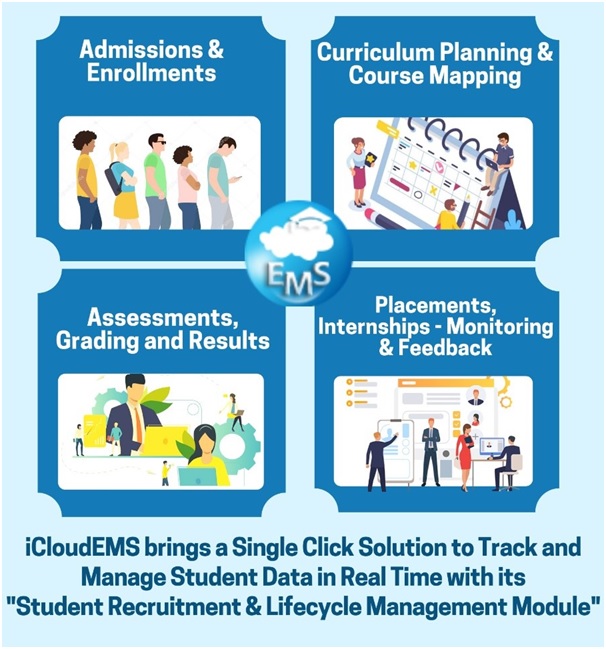
Earlier, before the appearance of web-based technologies, student’s success was very much dependent on a lot of manual work in order to organize marketing & branding activities so that new prospects can be attracted. Other target of that tedious task was to track students’ interests, nurture them through consistent engagement, scholarship programs to help deserving and meritorious students etc. and after all this work, a student’s academic journey actually started. Once the journey begins, retention and progress become the next important goals but knowing and understanding along with maintaining the information of every single student is a herculean task. Moreover, once the students graduate from the institution and start their career, there comes another challenge comes forward i.e. staying connected to the alumni, facilitating a friendly environment for them so that they willingly come forward to mentor the new students who need a role model to follow their footsteps and improve their chances of employ ability and add value and reputation to the institution. So, Student Lifecycle can be represented as a complete circle of an important journey which decides the future of the students.
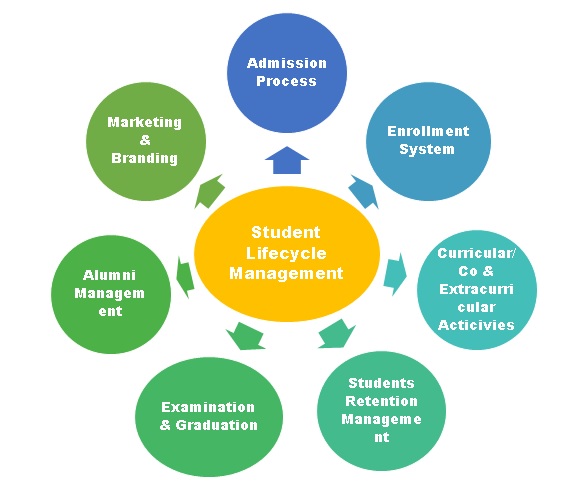
As discussed above, we can see how it becomes necessary for all the educational institutions to sustain the information of each and every student without making any mistake.
iCloudEMS through its unique product ‘Student Life Cycle Management’ provide the solution to the challenges faced by Educational Institutes like:
- Improvement in resource management.
- Softcopy based or paperless campus management.
- Errorless and Efficient Administration.
- Automating Payment Process.
- Safe & Secured Student information system management.
- Recording of attendance and maintenance of data.
- Effective Online Classes and Proctored Online Exams.
- Generation of Results along with Grades without any grievances.
- Augmentation in daily productivity.
- Assurance of Quality Education.
- Making campus management cost-effective.
- Providing platform for new opportunities.
Role of iCloudEMS in maintaining the Students Lifecycle can be identified as follows:
- Supervised and complete Automated Processes: It is difficult for the Management to handle all the processes at single point and that’s why our product Students Lifecycle management system automates all the systems and helps the management to monitor the institutional work at micro as well as macro level.
- Centralized Power and control over multiple departments: In the educational Institute, there can be multiple departments which can be unmanageable sometimes. With the help of our product, the management can have a centralized control over different departments on a single screen.
- Data driven updates and instant reports: Management of an institution can get the required data on a single click and can keep themselves updated about the institution’s daily activities. Moreover, instant reports can be generated at any time without any error and confusion.
- Data Security: Our product provides high technology security to make sure that the data is well secured & managed.
- Tracking of Student’s Admission: Our product makes tiresome jobs like applications & admission process easy with its reliable online process.
- Fee Collection & Revenue Management: Our managed services assist in fee collection, receipt generation and data maintenance online without any computational errors because a minor mistake can have a major impact on the cash flow.
- With the help of our product, teachers can take digital attendance, track lectures, students’ performance and upload important materials and assignment with burdening themselves with excessive work load.
- Our product Student Lifecycle Management System facilitates an easy communication between students & parents and later on with the alumni who can play an integral role in students’ retention process.
- Students can view their attendance, timetables, academic calendar and results without taking much trouble. iCloudEMS with the help of its LMS, provides a learning platform for the students to attend online classes, take their assessment exams and try to attain the course outcomes for overall development. Moreover, it also keeps the records of placed and unplaced students as per campus recruitment management program.
- iCloudEMS with its product plays an integral role in managing the students’ data strengthening the Alumni Management System by handling all the information related to a student once they graduate. If the institution shows concern to the alumni in their future endeavours, the same attitude will be reflected from them as well. They can willingly become a donor by showing their concern about the institution and guide their juniors to become a valuable asset for the same institution.
To conclude, we can say that iCloudEMS with its effective product Students Lifecycle Management System proposes a purpose-built, highly effective, techno-friendly solutions which can be customized as per the needs of the institutions that are relying on the working of ERP for improved admission, students’ retention, academic achievements, career needs and overall satisfaction while completing an important phase of their lifecycle.










